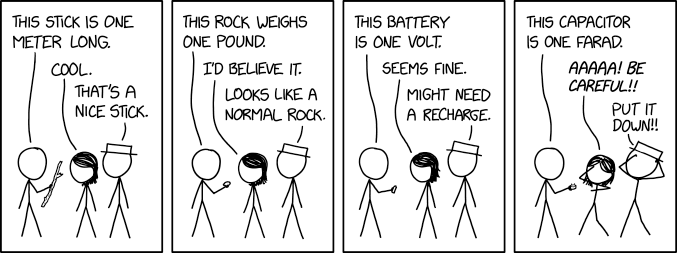Farads

'This HAZMAT container contains radioactive material with activity of one becquerel.' 'So, like, a single banana slice?'

'This HAZMAT container contains radioactive material with activity of one becquerel.' 'So, like, a single banana slice?'
In the comic, Cueball shows off several items that comprise approximately one of a given unit to Megan and White Hat. The first three — meters, pounds and volts — are all units of which "1" is a not extraordinary amount for an item that can be easily held in the hand. As such, they elicit minimal reaction from Megan and White Hat. A meter (a unit of length) is visually verifiable; a pound (a unit of weight) is easy to hold in the hand; and a volt (V, a unit of electric potential) would cause minimal harm even if discharged. White Hat's remark that the battery "might need a recharge" refers to the fact that 1 V batteries are somewhat uncommon, but a battery with a larger voltage like an AA, C or D cell (typically up to 1.5 V) might read as 1 V if significantly depleted, which is likely to make most electrical devices stop working or have performance decline.
In contrast, 1 farad is an unusually large amount of capacitance. Capacitance is the ability to store charge, a large amount of which could be dangerous. In common use, most consumer electronics use capacitors in the picofarad to millifarad range, and 1 millifarad is already considered a "large" capacitor. A 1-farad capacitor is considered a supercapacitor (and some of which are pseudocapacitors, not strictly capacitors). Cueball claiming to have a 1 farad capacitor elicits panic from Megan and White Hat, who fear that it could be very dangerous.
For the same charging voltage and load/resistance, a larger capacitor won't deliver greater current or instantaneous power than a smaller one, but the total amount of energy and duration of discharge would be proportionally longer. If the capacitor's wires accidentally touch each other or a third piece of metal, an accidental "short circuit" is created, and all of the capacitor's stored energy discharges very quickly. For example, a 1 farad capacitor charged to 10 volts stores 50 joules of energy, and discharging all of that into a copper wire could cause the wire to heat up by a few dozen degrees Celsius faster than the blink of an eye and cause serious burns (see the calculation). Large capacitors are often associated with larger voltages and heavy machinery, which can contribute to the feeling of caution around large capacitances.
The title text explores the inverse situation, where “1” of a unit is a very small amount. A becquerel (Bq) amounts to one radioactive atomic decay per second, which is a really low level of radioactivity. As observed, the material in question could be a single slice of a banana (primarily due to the decay of trace potassium-40 in the total potassium it contains, a natural proportion of 117 parts per million). Hence, it is both impractical and unnecessary to contain it inside a container for hazardous materials unless the material is dangerous for other reasons (such as corrosiveness, flammability, or overripeness). For comparison, a 70 kg human body itself has an activity of 8000 Bq, and the 1986 meltdown of the Chernobyl nuclear power plant (better known as the time "we banged some rocks together too hard") released 2×1018 (which is 2,000,000,000,000,000,000) Bq. The earlier common unit for radioactivity is the curie, originally defined as the decay rate of 1 gram of radium. It has since been redefined to be 3.7×1010 decays/second, i.e., 37 GBq. Radioactive material emitting 1 curie that is small enough to fit into a container for hazardous materials is dangerous enough that it probably should be in one. Bananas as a unit of measurement for radiation exposure are also discussed in the Radiation chart.